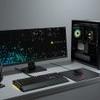Final Words & Conclusion
Final Words & Conclusion
Much like the 4000D, the build quality of the 5000D is lovely. Next to that, the top side has changed, and of course, inside, you'll have more room with a really nice option to place a radiator next to the motherboards. Thanks to the new top side design, the chassis looks better than the 4000D as well, albeit that, of course, is a bit of a subjective thing to state. The frontside and bezel have a nice sturdy feel to it being all metal, and then the design is elaborate with the nice tempered glass panel. Now, you have seen that in our acoustic test, the fans are quiet but at higher RPM, not silent. Hey, with the airflow gaps, lower fan RPM a notch, and you'll never hear anything from this chassis fan wise. The dark interior and cable management will complement your components. Despite its roomy interior, the 5000D feels like a compact looking chassis; you can house anything starting at E-ATX motherboard wise, anything smaller will fit in there, but anything of a larger form factor would be an issue (XL-ATX, which is rare these days).
Aesthetics
The looks then; yes, there is nothing more subjective about this chapter, but we feel it's a stylish looking product. The new top side definitely gives it a more premium finish. It has nice dark looks overall, and nothing screams out loud with logos. The new yellow signature accents that Corsair is placing gradually into their product could be irksome for some, but that's definitely not bothersome for this editor. If you want RGB, then there is the option for that RGB version as well; of course, adding an LCS RGB based would get you there as well. The dark tint tempered glass will make you look inside the PC and its components. Nice to see is that everything is black, from the dust filters to USB 3.0 integration and rubberized grommet holes.
Features
The internals are great, properly sized E-ATX form factor motherboards will fit, the most lengthy graphics card will fit problem-free. There's also good space for liquid cooling on the front side and top side. The icing on top of the cake is the ability to place a rad or RGB vans next to the motherboard, and there are plenty of configuration options for that. The drive bay has sufficient space for two HDDs, and you can install plentiful 2.5" SSDs (which are slowly getting replaced by NVMe M.2 storage these days as well, of course). The chassis has nice motherboard cut-outs with that gutter, and there's much space left for cable routing, all in that all-black interior. For PSU installation, the HDD bay needs to come out, though. However, it's removed with two thumbscrews and then re-inserted just as easily.
The Verdict
Ooh, I really like this one. It's a bit of a personal thing to say, I admit; the tested model's dark design paired with aesthetics and overall features will definitely please many. The top side has been revamped, the nice option for an LCS next to the motherboard, it all is nice. The rest of your components can be nicely hidden away. Aside from a bit too much marketing gobble like 'AirGuide technology,' 'anti-vortex,' and words like RapidRoute, we feel the new 5000D series offers refined looks and features. The cooling performance is adequate for this base model; need more? Opt the AIRFLOW version from mesh; however, that's at the cost of the clean looks. The two included fans are fairly silent but perform 'mid-range.' There's lots of room in the front for a nice LCS, and you get easy access there as well. Overall the chassis is easy to use and fairly maintenance free, with the easy to clean magnet-based dust-filters. You'll have enough storage options alongside proper cable routing and management options. For 150 USD for the base model as tested today, we feel Corsair offers a compelling and good-looking product. When you start building your system, it does all feel premium and well done. Pricing certainly isn't cheap; however, personally, I am always willing to spend a bit more on a proper chassis, as that's the product you'll be looking at all the time in that gaming room of yours.
- Sign up to receive a notification when we publish a new article
- Or go back to Guru3D's front page.


